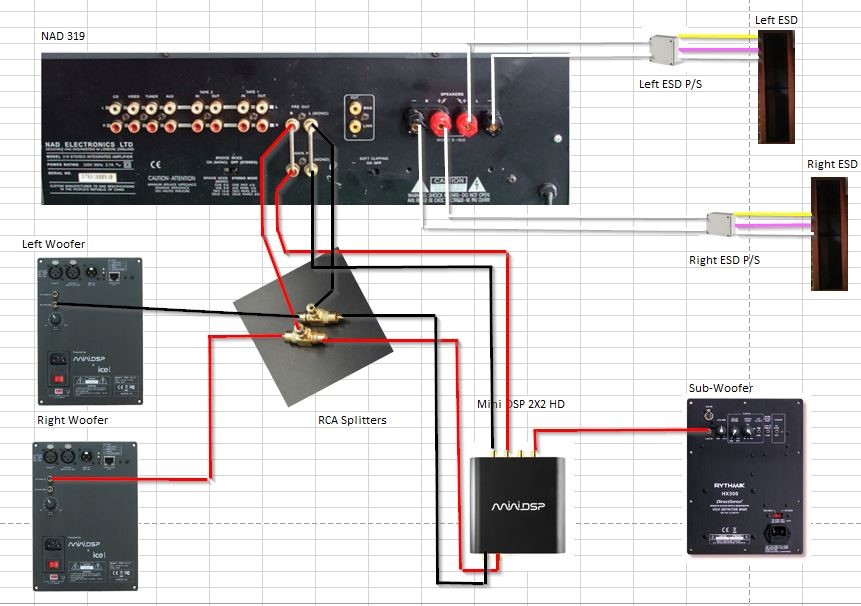Greg’s 505 Project
Greg came to us some time ago with the intention of buying some used Quad electrostatic loudspeakers that required a full panel rebuild.
When Greg described his room and indicated that the only place the speakers could go was on top of a cabinet some 900mm above the floor level, close to the corners and up against the rear wall I must confess I was somewhat skeptical he would get a good result and told him so.
The main issue he had was a built in cabinet that was the full width of the room, there was no option to place speakers in front of it so they had to go on top of it or be attached to the wall.
After looking at what was involved and discussing the position in the room that Quads require he decided not to go ahead with that idea and looked at our 505 panels as an alternative. The 505 panels can be wall mounted as long as the rear sound wave is deflected off to the sides rather than being reflected straight back onto the panel diaphragm, where it is re-radiated, muddying the sound. This requires a triangular shaped mount.
I was still worried that performance would be poor because the placement of the panels and the dynamic drivers used for bass frequencies was still less than optimum, however these were the only options Greg had to play with.
I’ll leave Greg to tell the rest of the story
DIY Stacked 505 Mini-panel Project
Perth Western Australia
Early Passion for Audio
I have had a strong interest in audiophile equipment since the early 1970’s.
At that time I assembled a system, that consisted of a Thorens TD165 turntable , Shure V15 type 3 cartridge and stylus, a pair of Bose 901 series 3 speakers, powered by a Denon 100w per channel amplifier.
This system served me well until the 1990’s, when I ventured into the world of 5.1 Surround Sound and big screen TV’s.
As a result, I drifted away from audio Hi Fi.
Late in 2017 my vinyl collection was in storage, and I was longing to listen to vinyl again.
It was about this time that I decided to re-commission the audio Hi Fi system.
I created a new separate listening room dedicated to vinyl ( and CD).
I had the Bose active equaliser re-built, in the USA by and ex Bose factory technician. All the amplifiers and capacitors were replaced.
The performance of the Bose after the re-build was much improved, but I felt the sound was NOT what I was seeking.
I swapped out the Bose 901’s, for a pair of Dynaudio Audience 70’s , which were better, but I was still not satisfied with the top end, nor the bottom end performance.
ESD Speakers (Normally called ESL’s, Rob)
My thoughts turned to ESD speakers, and due to the exorbitant cost of retail ESD speakers, I was considering purchase on some second hand Quad ESD speakers, (which I was told would require ESD panel refurbishing)
The owner of these second hand Quads, had purchased a refurbish kit from ER Audio in Perth, but had never got around to doing the refurbishment himself.
I decided to consult with ER Audio directly, to find out was involved in refurbishing. This was when I first met Rob Mackinlay.
After discussions with Rob, I was starting to feel like an ESD refurbishment project was not for me.
DIY ESD Speakers
It was about this time that Rob introduced me to his 505 mini-panels and I decided that a new purchase was far more desirable option. The price was very attractive, as it is a DIY solution.
I worked with Rob over several months discussing my desired system design utilising his 505 mini-panels.
I visited Rob’s home in Perth where he demonstrated his 505 mini-panels/ 8 inch Woofer combination for me. This initial demonstration was amazing, and I knew from that moment the Audience 70’s had to go.
Rob’s reference track was Chris Rea’s Road to Hell parts 1 and 2. This is a must have to listen to, for anyone with ESD panels.
I mentioned to Rob that I generally liked my music quite loud, and with plenty of bass capability, and he suggested that I consider the stacked 505 mini-panel, as these would effectively deliver twice the sound pressure levels for the same input. This was great advice.
We also discussed the need for special mounting arrangements for the stacked 505 minipanels to prevent rear sound pressure waves from reflecting back into the panel, thus causing unwanted distortion.
Bass augmentation
I asked Rob if he had any experience with Woofers and Sub-Woofers, which would integrate with the 505 Panels.
Rob indicated to me that I might need to supplement to bottom end, as my preference was for strong bass. The Rhythmik would look after my strong bass capability needs.
Rob indicated that he had heard Rhythmik Sub-Woofers, in conjunction with ESD panels and that they seemed to work well.
Rob was very generous with his time both in person, and via email, and telephone contact, and assisted me greatly in the system design phase of my project.
He did this for without charge, simply for the passion for what he does, and I felt that he could see I shared his passion.
Woofer and Subwoofer Specification/ Cabinet Design
With Rob’s suggestions on board, I sought out the Australian distributor of the Rhythmik Sub-Woofer, and consequently developed a close working relationship with Redspade Audio, in Melbourne Australia.
Red Spade Audio specialises in high end loudspeaker design and room acoustics.
Redspade were contracted to specify suitable Woofers and Sub-Woofer, to meet the needs of my difficult listening area. Redspade also specified miniDSP 2X4HD for system equalisation, crossover control and Woofer, Sub-Woofer ESD panel integration.
Redspade specified 8 inch powered SB Acoustics Woofers, fitted with PWR-ICE 125 watt plate amplifiers.
Due to my somewhat unconventional mounting (Woofers and Sub-Woofer mounted approximately 1 meter off the floor, and on a cabinet), Redspade specified a single side firing Sub-Woofer for my project.
Redspade specified a 12inch servo controlled and powered Rhythmik Sub-Woofer (DS1200), fitted with a 300 watt plate amplifier (HX300)
I also contracted Redspade to design cabinetry drawings for the enclosures and had a local cabinetmaker build the enclosures for me. The local cabinet maker also made the ESD wall mount for the ESD panels as specified by ER Audio in the application notes.
I also contracted Redspade to conduct system wide integration and room acoustic testing.
Redspade specified that I would need a UMIK Sound measurement microphone for system integration and testing, and also suggested I use the free downloadable software Room Equalisation Wizard (REW) for room acoustics analysis.
Integrated System Design

System Integration and Room Acoustic Testing
The Woofer plate amplifiers are connected to the laptop via the home wireless network whilst the mini DSP is connected to the Laptop via USB port connection.
Redspade conducted remote testing of the ESD panels, Woofers and Sub-Woofer, and implemented room equalisation, via PEQ filters embedded in the plate amplifiers for the Woofers, and in the mini DSP, for the ESD panels and the Sub-Woofer.
The testing was done using swept sine wave signals output from the sound output from the laptop into and auxiliary input on the NAD amplifier. The sound waves were detected by the Umik microphone in the listening position, and routed back to the REW software in the laptop via the Umik microphone’s USB input. The REW software performs the acoustic analysis and correction as required.
Remote testing and calibration was achieved by using Team Viewer, and conventional telephone for verbal communication with Redspade.
Redspade also implemented a separate bass and treble control in the miniDSP, with access to those controls via the laptop, whenever listening to music.
Results
The end result has exceeded any expectations that I had, before committing to the project.
The integration is tight and the top and bottom end response is nothing short of spectacular.
The sound stage is well defined, and the Rhythmik bass is both subtle and yet powerful when required.
The mini panels drive hard and precise in the top end.
I have Rob Mackinlay to thank for his time he spent consulting with which has resulted in the successful implementation, of quite a complex project, in what Rob has described, as a challenging listening environment.
Rob was good enough to visit my house for a show and tell session. He also is impressed at the result.
